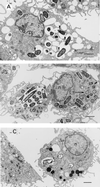Characterization of the interaction between Yersinia enterocolitica biotype 1A and phagocytes and epithelial cells in vitro
- PMID: 10456876
- PMCID: PMC96754
- DOI: 10.1128/IAI.67.9.4367-4375.1999
Characterization of the interaction between Yersinia enterocolitica biotype 1A and phagocytes and epithelial cells in vitro
Abstract
Yersinia enterocolitica strains of biotype 1A are increasingly being recognized as etiological agents of gastroenteritis. However, the mechanisms by which these bacteria cause disease differ from those of highly invasive, virulence plasmid-bearing Y. enterocolitica strains and are poorly understood. We have investigated several biotype 1A strains of diverse origin for their ability to resist killing by professional phagocytes. All strains were rapidly killed by polymorphonuclear leukocytes but persisted within macrophages (activated with gamma interferon) to a significantly greater extent (survival = 40.5% +/- 17.4%) than did Escherichia coli HB101 (9.3% +/- 0.7%; P = 0.0001). Strains isolated from symptomatic patients were significantly more resistant to killing by macrophages (survival = 48.9% +/- 19.5%) than were strains obtained from food or the environment (survival = 32.1% +/- 10.3%; P = 0.04). Some strains which had been ingested by macrophages or HEp-2 epithelial cells showed a tendency to reemerge into the tissue culture medium over a period lasting several hours. This phenomenon, which we termed "escape," was observed in 14 of 15 strains of clinical origin but in only 3 of 12 nonclinical isolates (P = 0.001). The capacity of bacteria to escape from cells was not directly related to their invasive ability. To determine if escape was due to host cell lysis, we used a variety of techniques, including lactate dehydrogenase release, trypan blue exclusion, and examination of infected cells by light and electron microscopy, to measure cell viability and lysis. These studies established that biotype 1A Y. enterocolitica strains were able to escape from macrophages or epithelial cells without causing detectable cytolysis, suggesting that escape was achieved by a process resembling exocytosis. The observations that biotype 1A Y. enterocolitica strains of clinical origin are significantly more resistant to killing by macrophages and significantly more likely to escape from host cells than are strains of nonclinical origin suggest that these properties may account for the virulence of these bacteria.
Figures


Similar articles
-
An aflagellate mutant Yersinia enterocolitica biotype 1A strain displays altered invasion of epithelial cells, persistence in macrophages, and cytokine secretion profiles in vitro.Microbiology (Reading). 2007 May;153(Pt 5):1339-1349. doi: 10.1099/mic.0.2006/000919-0. Microbiology (Reading). 2007. PMID: 17464048
-
Identification of virulence-associated characteristics in clinical isolates of Yersinia enterocolitica lacking classical virulence markers.Infect Immun. 1998 Mar;66(3):1113-20. doi: 10.1128/IAI.66.3.1113-1120.1998. Infect Immun. 1998. PMID: 9488403 Free PMC article.
-
Yersinia enterocolitica isolates of differing biotypes from humans and animals are adherent, invasive and persist in macrophages, but differ in cytokine secretion profiles in vitro.J Med Microbiol. 2006 Dec;55(Pt 12):1725-1734. doi: 10.1099/jmm.0.46726-0. J Med Microbiol. 2006. PMID: 17108278
-
Toxigenic Properties of Yersinia enterocolitica Biotype 1A.Toxins (Basel). 2022 Feb 5;14(2):118. doi: 10.3390/toxins14020118. Toxins (Basel). 2022. PMID: 35202145 Free PMC article. Review.
-
Interactions between Yersinia enterocolitica and the host with special reference to virulence plasmid encoded adhesion and humoral immunity.Dan Med Bull. 1992 Apr;39(2):155-72. Dan Med Bull. 1992. PMID: 1611921 Review.
Cited by
-
Symptoms and sources of Yersinia enterocolitica-infection: a case-control study.BMC Infect Dis. 2010 May 20;10:122. doi: 10.1186/1471-2334-10-122. BMC Infect Dis. 2010. PMID: 20487529 Free PMC article.
-
Gene polymorphism analysis of Yersinia enterocolitica outer membrane protein A and putative outer membrane protein A family protein.BMC Genomics. 2014 Mar 16;15(1):201. doi: 10.1186/1471-2164-15-201. BMC Genomics. 2014. PMID: 24628971 Free PMC article.
-
Characterisation and antibiotic resistance of Yersinia enterocolitica from various meat categories, South Africa.Onderstepoort J Vet Res. 2022 Nov 7;89(1):e1-e11. doi: 10.4102/ojvr.v89i1.2006. Onderstepoort J Vet Res. 2022. PMID: 36453823 Free PMC article.
-
Detection, distribution and characterization of novel superoxide dismutases from Yersinia enterocolitica Biovar 1A.PLoS One. 2013 May 21;8(5):e63919. doi: 10.1371/journal.pone.0063919. Print 2013. PLoS One. 2013. PMID: 23704955 Free PMC article.
-
Homologues of insecticidal toxin complex genes in Yersinia enterocolitica biotype 1A and their contribution to virulence.Infect Immun. 2005 Oct;73(10):6860-7. doi: 10.1128/IAI.73.10.6860-6867.2005. Infect Immun. 2005. PMID: 16177365 Free PMC article.
References
-
- Apicella M A, Ketterer M, Lee F K N, Zhou D, Rice P A, Blake M S. The pathogenesis of gonococcal urethritis in men: confocal and immunoelectron microscopic analysis of urethral exudates from men infected with Neisseria gonorrhoeae. J Infect Dis. 1996;173:636–646. - PubMed
Publication types
MeSH terms
LinkOut - more resources
Full Text Sources

